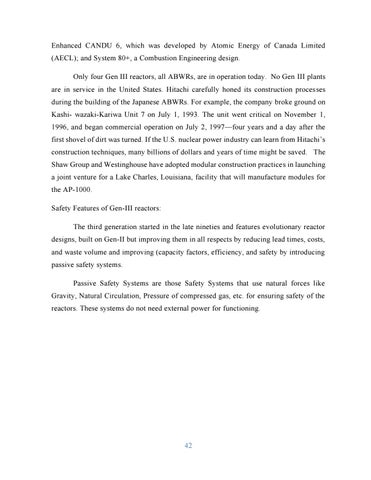Enhanced CANDU 6, which was developed by Atomic Energy of Canada Limited (AECL); and System 80+, a Combustion Engineering design. Only four Gen III reactors, all ABWRs, are in operation today. No Gen III plants are in service in the United States. Hitachi carefully honed its construction proces ses during the building of the Japanese ABWRs. For example, the company broke ground on Kashi- wazaki-Kariwa Unit 7 on July 1, 1993. The unit went critical on November 1, 1996, and began commercial operation on July 2, 1997—four years and a day after the first shovel of dirt was turned. If the U.S. nuclear power industry can learn from Hitachi’s construction techniques, many billions of dollars and years of time might be saved. The Shaw Group and Westinghouse have adopted modular construction practices in launching a joint venture for a Lake Charles, Louisiana, facility that will manufacture modules for the AP-1000. Safety Features of Gen-III reactors: The third generation started in the late nineties and features evolutionary reactor designs, built on Gen-II but improving them in all respects by reducing lead times, costs, and waste volume and improving (capacity factors, efficiency, and safety by introducing passive safety systems. Passive Safety Systems are those Safety Systems that use natural forces like Gravity, Natural Circulation, Pressure of compressed gas, etc. for ensuring safety of the reactors. These systems do not need external power for functioning.
42









